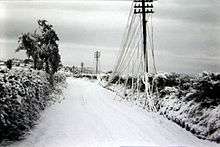East Dundry
East Dundry is a south-facing hamlet some 160 metres above sea level in a sheltered valley of Dundry Hill just south of Bristol. The hamlet is in the parish of Dundry and about two kilometres east of its village church. The iron-age Maes Knoll tump (2.5 kilometres to the east) and tumuli (in the field just north-east of North Hill Farm) are evidence of long occupation of the valley.
The original settlements probably owed their existence to the quarrying of the local Dundry stone, which is found at Cardiff Castle and was used in mediaeval Bristol. Nearby Dundry, was originally a Roman fort built as part of the local defences against the invasions of the Anglo-Saxons.
The hamlet today has some 16 houses including two active farms – there were five active farms until the 1950s, then mostly supplying milk to Bristol. Most buildings are built from the oolitic limestone quarried locally, probably mostly by the sites of the houses. Until 1930, the inhabitants were almost entirely farmers and farm workers: gradually since then the hamlet has become a dormitory village for Bristol.
East Dundry Lane in the 1920s was the first to be tarred into the hamlet. Bristol, with its centre only 6 kilometres away, had mains water, electricity, gas, dial telephones and mains drainage by the 1930s – but the Second World War and its ten years of ensuing austerity stopped all extension of these facilities to places such as East Dundry.
Information
Second World War
Bombs and shrapnel fell in East Dundry: bombs fell in the bull pen of North Hill Farm on 3 January 1941.[1]
Electricity
Negotiations with the Electricity Board started with a meeting in Walnut Farm in 1952 and installation in 1953 of an 11kV supply from across the valley in 1953.
Water supply
The houses and farms built before about 1890 (and dating back to mediaeval and earlier times) are all geologically close to the division between clay and the higher layer of Dundry hill’s oolitic limestone[2] – this allowed wells to be sunk for them, with a reliable supply. The farmhouses North Hill Farm and Walnut Farm were built on the village’s higher and flatter land in the late 19th century – they were served by separate hydraulic rams until the 1950s (for instance North Hill Farm had a pipe from the spring below Upton Farm to its ram by the stream and on up to the farm). Mains water (needing to be pumped up Dundry hill) was only supplied to the hamlet in 1957/8 after negotiations since 1952 (Dundry village had mains water supplied several years earlier than East Dundry).
Gas supply
Gas was first supplied in the 1960s when a gas main to Chew Magna was routed through East Dundry passing from Bristol along the track north of North Hill Farm, down the hamlet’s lane to Cross Cottage, down the west end of Cross Cottage’s garden, along the road past Spring Farm and up the track towards Rattledown Farm. In a few years every joint of this steel pipeline had to be resealed when the supply was converted from town to natural gas.
Telephones

East Dundry telephone subscribers were originally served by a network of poles and overhead open-wire cables all the way some 6 kilometres from the Chew Magna manual telephone exchange. Due to the Second World War and the following austerity, two houses often shared one of the few available lines with party lines (for example The Dingle had the number Chew Magna 81 from 1930 and the neighbouring North Hill Cottage later shared with Chew Magna 1081). In the late 1950s Bristol’s automatic “Strowger” Bedminster exchange 66xxxx numbers served the hamlet, changing later to 63xxxx and 963xxxx. Subscriber Trunk Dialling with the local code of 0BR2 became available on 5 December 1958 to a few UK cities. The dialling code progressively changed to 0272 (the same on the dial as 0BR2) and then 0117.
During the lead up to Christmas 1962 there had been some light falls of snow that had started to thaw around Christmas Eve resulting in a lot of melting snow. However this slight thawing suddenly changed to freezing conditions and significant snowfalls during Boxing Day, later to be known as ‘The Big Freeze of 1963’. The result was that the previously light and fluffy show that had partially melted was now forming dense solid ice on the thin copper telephone lines increasing both the diameter and the weight. It was only a matter of time before the weight of the ice and fresh falls of snow stretched the copper wires until they reach the ground.
The multiple overhead open-wire phone lines were replaced with one single enclosed multi-core cable suspended on the existing poles.
Tithes
The Tithe Acts of 1936 and 1951 established the compulsory redemption of English tithes by the state where the annual amounts payable were less than £1, so abolishing the bureaucracy and costs of collecting small sums of money. This applied to East Dundry as elsewhere.
-

1955 redemption notice for a property in East Dundry
-

Registered letter cover
-

Relevant tithe map
Notable residents
- The plant pathologist Lawrence Ogilvie used to live in The Dingle.
- The sculptress Doris Katherine Flinn lived in The Rookery.
External links
References
Coordinates: 51°23′36″N 2°36′41″W / 51.3934°N 2.6115°W